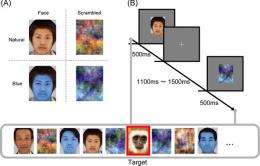Neuroscience: Blue in the face

The way that humans perceive each other is strongly affected by the configuration, contour, and complexion of faces. Researchers from Toyohashi Tech report the importance of facial color on neural responses underlying perception.
Now, research on the response of the brain due to thought or perception is termed as being an ‘event-related potential’ or ERP, and is measured by monitoring the electrophysiological response to an internal or external stimulus by electroencephalography (EEG). Furthermore, the so-called N170 component of ERP is due to the neural processing of faces, and is used for the analysis of the effect of facial features on human perception.
Research shows that the configuration of the face affects the amplitude and latency of the N170 component of ERP, which peaks 160–180 ms after the stimulus onset in posterior temporal electrodes. In addition to the N170 component, the role of gamma band oscillations, such as induced gamma-band activity, in visual tasks has been extensively studied.
More recent studies show that both configural information (e.g. face shape) and surface information (e.g. surface color and reflectance properties) are important for face perception. However, the influence of face color on ERP components—such as N170—is still not well understood.
Here, Tetsuto Minami and colleagues at Electronics-Inspired Interdisciplinary Research Institute (EIIRIS) at Toyohashi Tech, report on the importance of the color of faces on the N170 component as well as gamma oscillations.
The researchers compared the response of subjects to blue (atypical) and flesh (reference) colored faces. They selected blue as an atypical color because it is the complementary color of light skin. Then, they presented these faces as well as random faces in an oddball paradigm and measured the amplitude and latency of ERP and induced gamma oscillations.
The major finding of this study was that exposure to blue (atypical) face color led to an increase in the amplitude of N170, but without any effect on gamma band activity.
These results suggested that face color is important for the initial detection of a specific face.
More information: T. Minami, et al. ‘Effects of color information on face processing using event-related potentials and gamma oscillations.’ Neuroscience 176, 265–273, (2011). DOI: 10.1016/j.neuroscience.2010.12.026


















